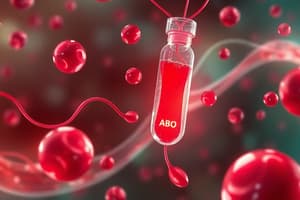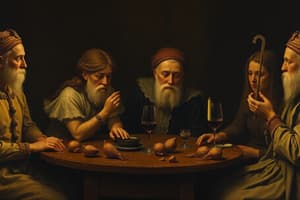Podcast
Questions and Answers
The O gene is considered dominant because it produces detectable antigens in response to inheritance.
The O gene is considered dominant because it produces detectable antigens in response to inheritance.
False (B)
The A and B genes are co-dominant and are responsible for producing transferases that convert the H substance to A and B antigens.
The A and B genes are co-dominant and are responsible for producing transferases that convert the H substance to A and B antigens.
True (A)
Inheritance of at least one H gene is necessary for the formation of the H substance.
Inheritance of at least one H gene is necessary for the formation of the H substance.
True (A)
The H gene codes for the production of D-galactosyl transferase.
The H gene codes for the production of D-galactosyl transferase.
The Se gene is responsible for the expression of H only on erythrocytes.
The Se gene is responsible for the expression of H only on erythrocytes.
The prevalence of the K antigen is 9% in the Black population.
The prevalence of the K antigen is 9% in the Black population.
MNSs are associated with resistance to Plasmodium falciparum invasion.
MNSs are associated with resistance to Plasmodium falciparum invasion.
Kell antigens are zinc metalloglycoproteins that possess neutral endopeptidase activity.
Kell antigens are zinc metalloglycoproteins that possess neutral endopeptidase activity.
The MNS system plays a major role in determining blood transfusion compatibility.
The MNS system plays a major role in determining blood transfusion compatibility.
Kpb antigen is present in 99.9% of the Caucasian population.
Kpb antigen is present in 99.9% of the Caucasian population.
Acquired B-like antigen was first recognized in 1959.
Acquired B-like antigen was first recognized in 1959.
The acquired B-like antigen is permanently retained by patients after recovery from infection.
The acquired B-like antigen is permanently retained by patients after recovery from infection.
The acquisition of B antigen usually occurs in persons with the A2 phenotype.
The acquisition of B antigen usually occurs in persons with the A2 phenotype.
High levels of soluble ABH substances can inhibit the anti-A or anti-B reagent.
High levels of soluble ABH substances can inhibit the anti-A or anti-B reagent.
Weakening of the A antigen is only noted in patients with infections.
Weakening of the A antigen is only noted in patients with infections.
Naturally occurring antibodies of the P, Lewis, and MN system are clinically significant.
Naturally occurring antibodies of the P, Lewis, and MN system are clinically significant.
The MN antigen is encoded by genes located on chromosome 4q28-q31.
The MN antigen is encoded by genes located on chromosome 4q28-q31.
The MNS blood group system is clinically significant due to its high immunogenicity.
The MNS blood group system is clinically significant due to its high immunogenicity.
Isoantigens are unique to each species, including humans.
Isoantigens are unique to each species, including humans.
Alloantigens are present in every individual of a species.
Alloantigens are present in every individual of a species.
Karl Landsteiner discovered that blood samples can react strongly or mix without reaction when cross-tested.
Karl Landsteiner discovered that blood samples can react strongly or mix without reaction when cross-tested.
Group AB blood cells have neither A nor B antigens on their surface.
Group AB blood cells have neither A nor B antigens on their surface.
The antibody that reacts with B cells is called Anti-A.
The antibody that reacts with B cells is called Anti-A.
Bernstein proposed that there are three allelic genes: A, B, and O.
Bernstein proposed that there are three allelic genes: A, B, and O.
Individuals inherit two ABO genes, one from each parent.
Individuals inherit two ABO genes, one from each parent.
Anti-A antibodies are present in the serum of individuals with Group A blood.
Anti-A antibodies are present in the serum of individuals with Group A blood.
The H antigen is important because it is the foundation upon which the A and B antigens are built.
The H antigen is important because it is the foundation upon which the A and B antigens are built.
The O allele alters the structure of the H antigen.
The O allele alters the structure of the H antigen.
Group A individuals have the greatest amount of H antigen compared to other blood types.
Group A individuals have the greatest amount of H antigen compared to other blood types.
A typing serum prepared from anti-A of a group B person adsorbed with A2 cells will agglutinate A2 but not A1 erythrocytes.
A typing serum prepared from anti-A of a group B person adsorbed with A2 cells will agglutinate A2 but not A1 erythrocytes.
The presence of the Se gene determines whether an individual is a secretor or non-secretor of ABH antigens.
The presence of the Se gene determines whether an individual is a secretor or non-secretor of ABH antigens.
All individuals with blood group A possess the same amount of H antigen.
All individuals with blood group A possess the same amount of H antigen.
Distinguishing between A1 and A2 blood types is critical for routine blood transfusions.
Distinguishing between A1 and A2 blood types is critical for routine blood transfusions.
There are three known subgroups of type B blood.
There are three known subgroups of type B blood.
D-galactosyltransferase is the enzyme coded by the A gene.
D-galactosyltransferase is the enzyme coded by the A gene.
A2B individuals' serum may contain anti-A in levels up to 25%.
A2B individuals' serum may contain anti-A in levels up to 25%.
Individuals with Group A blood only have A antigens on their red blood cells.
Individuals with Group A blood only have A antigens on their red blood cells.
There are equal percentages of A1 and A2 subgroups in blood group A.
There are equal percentages of A1 and A2 subgroups in blood group A.
The presence of a superactive B transferase does not affect the expression of A antigens on erythrocytes.
The presence of a superactive B transferase does not affect the expression of A antigens on erythrocytes.
Acquired A antigen can occur in individuals with type O blood as a result of severe infections.
Acquired A antigen can occur in individuals with type O blood as a result of severe infections.
Mixing of blood does not affect the expression of ABH antigens on erythrocytes.
Mixing of blood does not affect the expression of ABH antigens on erythrocytes.
The Khosian people of South Africa have the highest frequency of the Bantu A subtype.
The Khosian people of South Africa have the highest frequency of the Bantu A subtype.
Flashcards
O Gene Inheritance
O Gene Inheritance
The O gene does not produce any transferase enzyme, resulting in no detectable substance (H) production.
A and B Gene Inheritance
A and B Gene Inheritance
A and B genes are inherited independently of H, Sese genes, producing either A or B antigens on erythrocytes (red blood cells) or body fluids.
H Gene Function
H Gene Function
The H gene codes for L-fucosyl transferase, an enzyme that adds L-fucose to the precursor substance, creating the H substance.
A and B Gene Transferases
A and B Gene Transferases
Signup and view all the flashcards
Inheritance Pattern (A, B, O)
Inheritance Pattern (A, B, O)
Signup and view all the flashcards
ABO Blood Group System
ABO Blood Group System
Signup and view all the flashcards
Isoantigens
Isoantigens
Signup and view all the flashcards
Alloantigens
Alloantigens
Signup and view all the flashcards
Blood Group Antigens (A & B)
Blood Group Antigens (A & B)
Signup and view all the flashcards
Blood Group A
Blood Group A
Signup and view all the flashcards
Blood Group B
Blood Group B
Signup and view all the flashcards
Blood Group AB
Blood Group AB
Signup and view all the flashcards
Blood Group O
Blood Group O
Signup and view all the flashcards
H antigen
H antigen
Signup and view all the flashcards
A and B antigens
A and B antigens
Signup and view all the flashcards
N-acetylgalactosamine
N-acetylgalactosamine
Signup and view all the flashcards
D-galactose
D-galactose
Signup and view all the flashcards
O allele
O allele
Signup and view all the flashcards
Secretors
Secretors
Signup and view all the flashcards
Group A sub-groups (A1/A2)
Group A sub-groups (A1/A2)
Signup and view all the flashcards
ABO blood types
ABO blood types
Signup and view all the flashcards
A1 vs A2 Distinction
A1 vs A2 Distinction
Signup and view all the flashcards
Anti-A1 Antibody
Anti-A1 Antibody
Signup and view all the flashcards
B Subgroups
B Subgroups
Signup and view all the flashcards
A2 Importance in Transfusion
A2 Importance in Transfusion
Signup and view all the flashcards
Modifying Genes
Modifying Genes
Signup and view all the flashcards
Acquired A Antigen
Acquired A Antigen
Signup and view all the flashcards
Levine Hypothesis
Levine Hypothesis
Signup and view all the flashcards
Alternative Pathway
Alternative Pathway
Signup and view all the flashcards
Acquired B-like Antigen
Acquired B-like Antigen
Signup and view all the flashcards
Cause of Acquired B-like Antigen
Cause of Acquired B-like Antigen
Signup and view all the flashcards
Loss of Acquired B-like Antigen
Loss of Acquired B-like Antigen
Signup and view all the flashcards
High Soluble ABH Substances
High Soluble ABH Substances
Signup and view all the flashcards
Neutralization of Reagents
Neutralization of Reagents
Signup and view all the flashcards
MNSs System
MNSs System
Signup and view all the flashcards
MNSs Antigens
MNSs Antigens
Signup and view all the flashcards
Clinical Importance of MNSs System
Clinical Importance of MNSs System
Signup and view all the flashcards
Kell System
Kell System
Signup and view all the flashcards
Kell System's Clinical Significance
Kell System's Clinical Significance
Signup and view all the flashcards
Kell System's Function
Kell System's Function
Signup and view all the flashcards
Kell System's Composition
Kell System's Composition
Signup and view all the flashcards
Kell System's Location
Kell System's Location
Signup and view all the flashcards
Study Notes
ABO Blood Group System
- Blood group antigens are inherited factors found on red blood cells
- Isoantigens are antigens unique to each species
- Alloantigens are antigens common to some but not all members of a species
- Blood group serology identifies these antigens and corresponding antibodies
Discovery of Blood Groups
- Karl Landsteiner's research in the early 20th century showed that blood samples mix differently when cross tested
- Agglutination (clumping) was attributed to the presence of specific antigens on red blood cells and matching antibodies in the serum
- Different red blood cell antigens were identified as A and B
- Blood types are classified as A, B, AB, and O, based on the presence or absence of antigens A and B on the surface of red blood cells.
ABO Blood Groups: Antigens and Antibodies
-
Individuals with type A blood cells have only antigen A
-
Individuals with type B have only antigen B
-
Individuals with type AB blood have both antigens A and B
-
Individuals with type O blood have neither antigen A nor B
-
Individuals with type A blood have anti-B antibodies in their plasma
-
Individuals with type B blood have anti-A antibodies in their plasma
-
Individuals with type AB blood have neither anti-A nor anti-B antibodies in their plasma
-
Individuals with type O blood have both anti-A and anti-B antibodies in their plasma
ABO Blood Group Genetics
- Blood type is determined by three alleles (variants of a gene): A, B, and O
- Individuals inherit two alleles, one from each parent
- The O allele is considered recessive to A and B alleles
- A and B alleles are codominant (both expressed if present)
The H Gene
- The H gene codes for L-fucosyltransferase, an enzyme that adds L-fucose to the precursor substance
- The H substance acts as a foundation (precursor) for A and B antigens
- People with certain blood groups (e.g. type O) have naturally occurring more H antigens compared to others
A and B Antigens
- The A gene codes for N-acetylgalactosaminyltransferase
- The B gene codes for galactosyltransferase
- These transferases add specific sugars to the H antigen (creating A and B antigens)
Secretor Status
- The Se gene is responsible for the expression of A, B, and H antigens in body fluids like saliva, plasma, etc.
- 80% of Caucasians are secretors
Blood Group Subgroups
- A blood types can be further subdivided into A1 and A2
- 80% of individuals with type A are A1, 20% are A2
Other Blood Group Systems and Antigens
- Other blood group systems exist (besides ABO), each with its own antigens and subtypes
- Some, including MN, P, Kell, Lewis, Duffy, Kidd, and Rh, are important for clinical purposes for transfusion and transplantation
Detection of Blood Groups
- Detection methods often involve antibodies and agglutination which is used to detect blood typing
- Typically performed via antibody screening and cross matching process
Function of Antigens and Antibodies
- The presence and type of antigens determines the blood type
- The presence and type of antibodies in plasma ensures blood compatibility between donors and recipients
Rh System Features
- Discovered by Landsteiner and Wiener, and later researched by Levine and Stetson
- The Rh system is complex with several different antigens and variants
- The RhD antigen is critical to the Rh system which has several related proteins coded by multiple genes
- RhD inheritance largely determines Rh status (D+) or (D-) as positive or negative
Rh System Genetics
- The Rh factors are carried on a single chromosome (involving several different alleles)
Inheritance of Rh Genes and Factors
- The Rh system is inherited through a Mendelian pattern via several possible combinations
- Blood typing via antibodies is dependent upon antigen present
Direct and Indirect Coombs Tests
- Techniques for detecting antibodies attached to red blood cells
- Distinguished on their functions
Clinical Significance
- Blood typing is crucial for preventing transfusion reactions and hemolytic disease of the newborn
- Used in forensic science and paternity testing to identify individuals.
Studying That Suits You
Use AI to generate personalized quizzes and flashcards to suit your learning preferences.




